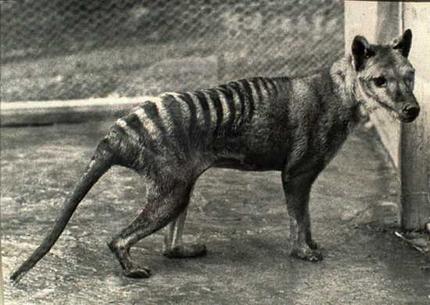
Bad enough that this rare beast, found only on the Australian mainland, New Guinea and Tasmania is gone but that its demise was mainly caused by the incursions and depredation of European settlers.
The Tasmanian Tiger was neither a feline nor a canine although it looked very much dog-like in body style and size. It shared a small classification of the genus, Thylacinus, with its cousin the Tasmanian Devil. In length the Tasmanian Tiger averaged between three and a half and four and a half feet long with a tale about two foot long. Matching the size of mid-sized dogs, the Tiger weighted in at between forty and seventy pounds.
While the Tiger's short fur was brown, from fawn to dark, the name was derived from the one to two dozen dark stripes that crossed its hindquarters and back. Both genders had the marsupial pouch; the female's having four teats to carry the average three joeys per litter until they were old enough to emerge and survive on their own. The male's pouch was used as protection for the scrotal sac as it hunted in heavy brush.
As a hunter, the Tasmanian Tiger depended more on sight and sound that smell as it did not have a well-developed olfactory sense. It had great stamina and was relentless in following its chosen prey until exhaustion brought it into reach of the large strong jaws of the Tiger. Reports vary as to whether the Tiger hunted alone or in small packs. Its usual prey included kangaroos, wallabies, small birds, and possums. It is thought they also hunted the Australian emu until its own extinction on the continent.
The demise of the Tasmanian Tiger began in earnest with the introduction of the dingo and wild dogs to Australia. The coming of Europeans sealed its fate. The preferred hunting ground of the Tasmanian Tiger included eucalyptus forests, coastal wetlands and open grasslands; mostly the same terrain prized by settlers for their farmlands. Considering the Tiger to be a potential livestock predator, a bounty was soon placed on the Tasmanian Tiger. Thousands perished under the guns of the farmers and bounty hunters. By the 1920's, sightings of the Tasmanian Tiger were rare. The last known Tiger to be killed in the wild was gunned down in 1930. A few remained in zoos and the last known Tiger died in captivity in 1936.
According to International standards fifty years passed without a Tasmanian Tiger being discovered so it was listed as officially extinct in 1986. Despite the classification, there are still reports of sightings, tracks and scat of the occasional Tiger in a few remote parts of Tasmania. Several agencies have offered substantial rewards for proof the Tiger is still with us although they have as yet gone unclaimed. That the last old growth forest of Tasmania are where these sighting occur, the continued logging of these areas will soon guarantee the last hope of finding a live Tasmanian Tiger will perish along with this creature.



